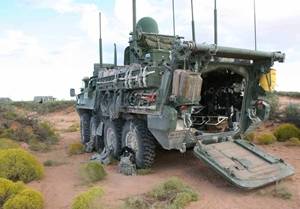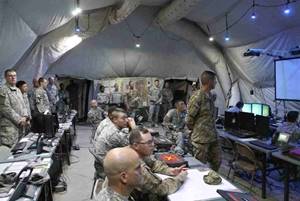FORT BLISS, Texas — During Network Integration Evaluation, or NIE, 16.1,Warfighter Information Network-Tactical, or WIN-T, the Army’s tactical communications network backbone supported an expanded exercise that included a coalition network, early entry airborne missions, and Army initiatives aimed at providing more expeditionary command posts.
“We are going to be covering some incredible distances, especially with airborne operations, which we couldn’t have covered with standard FM communications,” said Maj. Jeffrey Fulton, communications officer (S6) for the 2nd Brigade Combat Team, or BCT, 1st Armored Division, or 2/1 AD, the main operational unit for the NIEs. “With WIN-T Increment 2, the commander can have communications with the ground forces across the entire footprint of the battlefield. In fact, if he were on the West Coast, he could actually talk to another unit [and exchange data] on the East Coast, if they had the similar equipment.”
A MOBILE, EXPEDITIONARY NETWORK
Fielded since 2012, WIN-T Increment 2 enables Soldiers down to the company command level to maintain voice, video and data communications while on patrol with connectivity rivaling that found in a stationary command post.
Combat and tactical vehicles integrated with WIN-T Increment 2 provide the satellite and line-of-sight mobile communications and situational awareness that commanders need to lead from anywhere on the battlefield, whether at the Army’s NIEs or in current contingencies such as those in Iraq. Mission command systems integrated into these vehicles, as well as those in stationary command posts, need to connect to the WIN-T network to operate. WIN-T enables these systems to create a real-time common operational picture that can be shared across the joint and coalition battle space, enabling multiple units to fight as a single, well-informed force.
“WIN-T Increment 2 brings a whole suite of services to the commander on the move,” Fulton said “The system enables the commander to reach out and touch his subordinate commanders, to pass products to the staff and to have real time communications with elements that he never would have had prior to this capability.”
WIN-T Increment 2, which received a full rate production decision in May, serves as the backbone network for the Soldier-led NIEs, and will do the same for the Army’s new Army Warfighter Assessments, or AWAs, scheduled to begin next fall. Together these two bi-annual exercises, held on Fort Bliss, Texas, and White Sands Missile Range, New Mexico, will help modernize, develop and refine the broad scope of the Army’s tactical communications network and how it is used during tactical operations.
READY, SET, GO!

“RVPS works like a filling station,” said Lt. Col. (P) LaMont Hall, product manager for WIN-T Increment 2. “An ethernet cable runs from each of the brigade’s networked vehicles to a central switch and a single laptop with an easy-to-use web interface. From that laptop, a Soldier can merely hit a button and perform all the initialization, configuration and software load tasks, for all the vehicles, simultaneously. It will enable units to roll out to conduct on the move operations much quicker.”
RVPS is expected to be ready for evaluation at NIE 16.2 next spring. Following NIE 16.2, the RVPS capability will be tested with a few select fielded units and then eventually deployed to all fielded units.
NIE’S FIRST JOINT FORCIBLE ENTRY OPERATIONS

Once on the ground and the airfield was secured, air lands brought in more network and combat power, including new prototype WIN-T Increment 2-equipped Tactical Command Posts, or TACs. These junior tactical operation centers, or TOCs, are a small, highly-mobile package of select personnel and equipment designed to provide mission command and communications well forward of the main TOC. The WIN-T network enables Soldiers in these forward TACs to have the same mission command and network communications capabilities found in the main TOC, in smaller, more agile configurations.
“We are about to do about 160 kilometer air assault forward of this location [main brigade TOC],” said Col. Charles J. Masaracchia, commander for 2/1 AD. “That is going to be a complex fight up there and I believe my TAC needs to be there commanding and controlling those three battalions, leaving my TOC [safely] back here in the southern portion of our area of operations.”
Commanders also employ their mobile WIN-T Increment 2-equipped TACs forward when operations require them to move their large main TOC to a new location. The forward mobile TAC enables the unit to retain advanced communications and mission command while on the move or at the short halt, until the main TOC can be reestablished.
EXTENDING RADIO NETS
In addition to providing operational flexibility, advanced communications and mission command to the TOC, the TAC, and the commander and Soldiers on the move, WIN-T’s satellite capability can also extend tactical radio networks beyond-line-of-sight, keeping Soldiers connected over vast distances and terrain obstructions to significantly expand their operational reach. WIN-T Increment 2 provides “a communication platform for a very dynamic, rapidly developing battlefield,” said Sgt. Tomas Kozie, 4-17 Stryker Battalion, 17th Infantry Regiment, 2/1 AD, retransmission team chief, from inside his Stryker vehicle integrated with WIN-T Increment 2 Soldier Network Extension, or SNE, capability.
“If a unit is pushed too far away from their command, I can retransmit while on the move in my SNE,” Kozie said. “It really doesn’t matter how much distance I am from the command base, as long as I am within radio communication with the unit that I am supporting, I can retransmit [the radio signal] across the satellite, all the way back to New England if I had to.”
SOLDIER FEEDBACK IMPROVES CAPABILITY
The Army plans to continue to leverage exercises like NIEs and AWAs and the Soldier feedback they provide to continually improve network capabilities and how they are utilized on the battlefield. Based on Soldier feedback from theater and the NIEs, the Army made improvements in reliability, usability and simplicity to WIN-T Increment 2 capability, which were incorporated into the system’s full-rate production designs.
“When I was at my first NIE, 14.2, we didn’t’ have the current easy usability with WIN-T Increment 2,” said Chief Warrant Officer 2 Michale Tillery, network technician for 2/1 AD. “But once they changed the whole interface around, it has a smart-phone type interface now, non-signalers can operate and troubleshoot the system with no problem. It helped out the warfighter and that is what we want to do out here. I’m very happy.”


